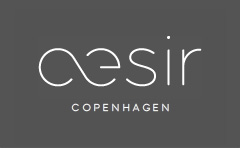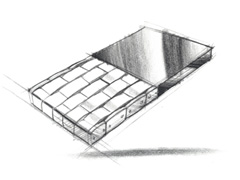YVES BÉHAR INTERVIEW
Q:
Can you give us an overview of what you have done here with Æsir and the Æ+Y phone?
YB:
With the Æsir phone, I wanted to show an alternative to the sea of smartphones and their deluge of features. In an age when the industry seems to think that phones aren’t for speaking anymore, I wanted to focus on the idea of voice, clarity and simplicity.
The central tenet behind the Æ+Y is to literally craft the visual details, craft the functional tactility, and craft the user interface. This level of resolution for every touch point was achieved using a European-centric approach to manufacturing, assembly and design, partnering with the best makers in Switzerland, France and the Netherlands. The Æ+Y champions the idea of craftsmanship in an age that’s obsessed with more and making last year’s products obsolete. Instead we propose better and long-lasting as our starting criteria.
Q:
There is a clear visual link between a watch and the Æ+Y. Why?
YB:
Well, it’s not so much the visual but the functional. The reason it’s important to talk about the watch world isn’t for its sense of luxury but for the engineering. Watches are so complex because of the conditions they’re placed in. A watch will be banged around all day long, thrown into a suitcase, and good watches are incredibly durable. If you think about how long your phone lasts and how long your watch lasts, even an average watch lasts for quite a long time and that changes people’s relationship with their watches as a result. Our expectation is the Æ+Y will have that kind of long life as well.
But, in terms of looks, it was important to me to make the phone clear and tactile – to work out the details and the proportions. Take the feel of the keys, for example, I wanted them to be very tactile. You can clearly differentiate one key from another. Additionally, they’re large and use principles of universal design, which makes them accessible to all and straightforward to use. The layout of the keypad does this as well.
At the same time as being very focused on the phone’s tactility and user experience, we’ve also designed a phone that requires incredible detail in manufacturing. We’re using techniques from jewelry-making and trying to balance all the parts and surfaces with the precision of watchmaking. We’ve used the best materials available to make something durable, personal and elegant.
Q:
How do the form and exterior design of the phone tie to its features and functionality?
YB:
Speaking to others is a key tool of the 21st century, and the phone is designed with that in mind. The voice function – making and receiving calls – will always be important and I looked at the phone as a way of capturing that elemental functionality. So we really crafted the phone around this notion – a bit like making an elegant carafe to hold water. Transporting water is something essential to life, and I was thinking of the phone as if I were making an elegant silver vessel or a glass carafe to hold water.
Q:
There is an elegance in the phone’s simplicity and a certain luxuriousness in a phone that focuses on speaking. Why did you feel this approach was the right one right now?
YB:
As I was designing it, I wasn’t thinking about a ‘product’, but the idea the phone conveys and what I wanted people to do and feel, and experience with it. I wanted to address the fundamental issues of voice and touch. I wanted the Æ+Y to be intuitive and work without people having to look at the keypad or screen. The problem with a touch screen is that unless you’re looking at it, you’re completely lost. So we lose a layer of intuitive function with touch screens. With a phone, I want to have something in my hand where I can explore its tactility. It allows me to use this phone without looking at it. I chose materials that would respond to touch and encourage that kind of interaction. That is all, in a sense, a response to what many phones are doing now.
Most companies try to cram as much technology into a product as possible rather than considering how you or I use that technology, and most other phones are just two pieces of plastic snapped together. But there’s also the issue of ‘feature creep’. You can find it in the majority of products out there. Good design uses the process of elimination. Hence I really wanted to focus on the essence of a phone.
Q:
How do you want people to respond to the Æ+Y?
YB:
Hopefully people will look at the phone in their hand and say: “Oh, that’s simple. “Or, “That’s resolved.” I don’t want them to look at it and see the design process. Things being simplified demand a human and emotional perspective that’s difficult to find in the tech sphere. Simplicity – clarity and simplicity – were really my guiding principles. The Æ+Y is a high-end craft product. It’s not been designed by addition but reduction to create something of integrity and performance.
Q:
How did you bring craft to a cell phone?
YB:
The handmade isn’t usually present in electronic products. Here it was all about adapting the available technologies and traditions to products that don’t usually have them. The Æsir guys are looking to make a phone using specialized technologies and traditions, many of which are rooted in Europe. I think it’s important, in the Danish culture that’s very proud of its craft and design tradition, to explore how to do this now in a 21st century product. That allowed us to focus on quality – to consider and develop the phone’s form and function.
Q:
Phones often have such short life cycles and the Æ+Y was designed to be enduring. Was addressing the idea of obsolescence an explicit part of your process?
YB:
I want a world where we do things better. I believe that we can. That’s why I’m here. I believe in sustainability and designing products to go from ‘cradle to cradle’. With the Æ+Y the idea is for it to be an upgradable, long-term product that you keep, much as you might keep a watch, rather than something you plan on throwing away and replacing regularly. Here we have metal buttons. You won’t be scratching off the graphics all the time because they’re embedded in the metal. The details are designed to both enhance the functionality and ensure that functioning lasts for a long time.
Q:
It must have been difficult getting that level of detail right for the Æ+Y.
YB:
When you work on something like this you take on challenges that at face value solve problems that seem extremely simple. For example, introducing new types of materials and new types of construction requires a great deal of research and hard work to achieve the level of refinement the Æ+Y demands.
Q:
How involved were you in the process and was it tricky finding suppliers? Many of them had to apply their expertise in new ways and embrace new challenges to make the Æ+Y.
YB:
We were involved from very early on. We were all trying to see, can this be made in Switzerland? Or Denmark? At the onset of a project like this you really have to ask yourself if it’s even possible to work with a whole new set of suppliers who nobody in the phone industry has ever worked with. So you ask yourself those tough questions and you realize that you’re taking an untravelled road. That was exciting. At the start none of us knew exactly how we’d get there or where it would take us, just like when I started on the $100 laptop. We had no clue whether it was even possible.
Q:
How long did the engineering take? Were there any difficulties in the process?
YB:
We’ve been in constant contact with the engineers. Together we looked at every single component. We certainly had some heated debates about how thin we could get it, and keeping the proportions to preserve the original idea of elegance for the phone. We just weren’t willing to compromise on this notion of crafted components. We started two and a half years ago, which is a long time when you consider that most phones are done in nine months to a year. In the time it took us to refine, engineer and find a whole new supplier route for the Æ+Y, we could have brought several more typical phones to market.
Q:
Focusing on the bespoke craftsmanship and functionality of a phone seems like an indulgence for a designer. What sort of issues has this process caused you to consider?
YB:
Few designers are focusing on why we really use a phone. Instead they put tons of extra features in them, but being able to explore that singular focus, to really work on embodying voice and enable that experience, was one reason I was drawn to the project. Like my One Laptop Per Child computers, working with Æsir allowed me to dig deep into a single issue, and that freedom and clarity has led to higher-quality solutions. Here I can go to the nth degree when it comes to the crafting and design. Æsir has a commitment to a sense of quality and craft and simplicity, and honestly I don’t know of anybody else who does.
Q:
What attracted you to working with Æsir?
YB:
Æsir is the dream of three guys from Denmark who wanted to bring a whole new criteria to the cell phone. They wanted to bring back the element of craft and quality, to create something handmade and hand-assembled.
I was impressed that they wanted to use bespoke European manufacturing, technology and assembly methods. So this product is more like a watch than your typical electronic product off an assembly line. As a designer that made it interesting to me – not that it was supposed to be a hard-to-get kind of thing. It seemed like a noble undertaking. I think that Europe needs to look at its manufacturing and maybe explore what it is that they can make, from a manufacturing standpoint that nobody else can. I’m proud that we all stuck to our aims and didn’t compromise on the phone’s quality or elegance.

